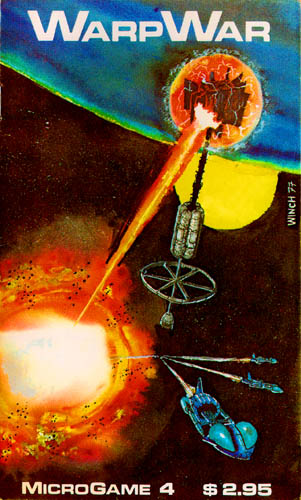


While I was still in high school (1977), right after doing the Ogre artwork, I was contracted to do the artwork for Metagaming's new game Warp War. As with Ogre, this game gained a cult following that continues to this very day. Unlike Ogre, I only get a fraction of the emails saying "OhMyGod! You're the guy who drew the Ogre!" I do get a few, though.
As with the Ogre, I read the draft rules for clues as to the appearance of the ships. I noted that the beam weapons and defensive force fields had a "rob-Peter-to-pay-Paul" arrangement, which suggested that they were combined into one unit.
Game designers who would like to play with a related "rob-Peter-to-pay-Paul" system are invited to go here under "power allocation".
There were non-FTL ships as well as starships. For the system ships, I recalled a bit from one of my favorite authors: Larry Niven.
from PROTECTOR by Larry Niven
He strapped it to the fusion tube of his ship, below the lifesystem cabin. The gyros could compensate for the imbalance...
If Brennan had found pitchblende the singleship would have been hung with cargo nets under the fuel ring, carrying its own weight in radioactive ore...
Nilsson's own small, ancient mining ship bad become the Ox's lifeboat. tube, flared at the end, stretched almost the length of the hold...
The captive ship was small. Phssthpok found little more than a cramped life support system, a long drive tube, a ring-shaped liquid hydrogen tank with a cooling motor. The toroidal fuel tank was detachable, with room for several more along the slender length of the drive tube. Around the rim of the cylindrical life support system were attachments for cargo, booms and folded fine-mesh nets.

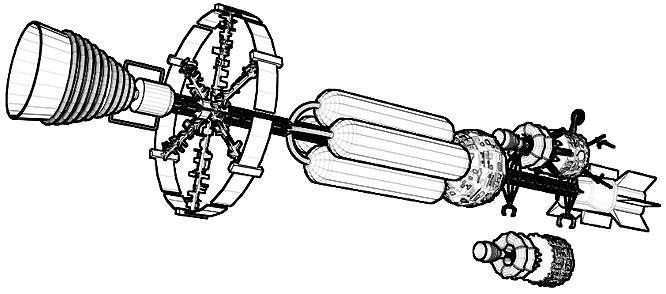
Examining the system ship below the starship you will see that it owes a lot to a Niven-esque Belter singleship. In the rear is the reaction drive based on a NERVA nuclear thermal propulsion system, the FTL propulsion ring, fuel tanks with missiles, the habitat sphere, system ships, and the combined beam/shield unit.
WarpWar analyst Henry Cobb estimates that the stats of the WarpShip in the drawing are approximately Power/Drive 7, Beam 3, Screen 3, Systemship racks 2, Cost 20. He estimates the system ships are approximately Power/Drive 1, Missile Tube 1, Missiles 3, Cost 3.
Now, as for my recently created CGI system ship with six tubes, WarpWar analyst John Reiher estimating that system ship as Power/Drive 12, Missile Tube 6, Missiles 18, Cost 24.
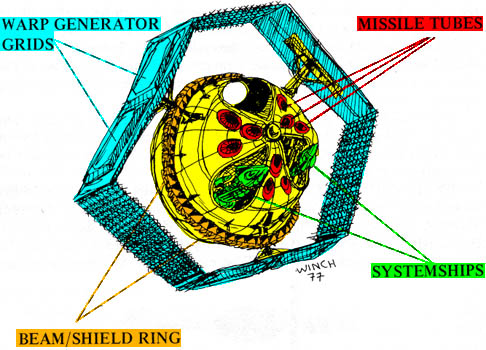
The blue team System ship design had a checkered history.
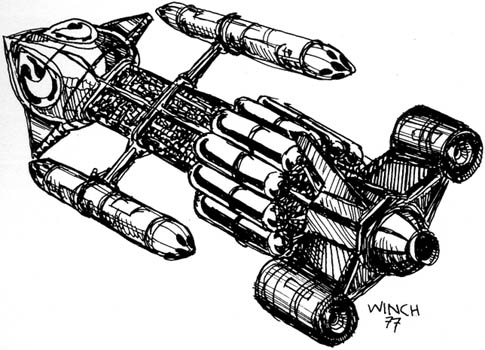

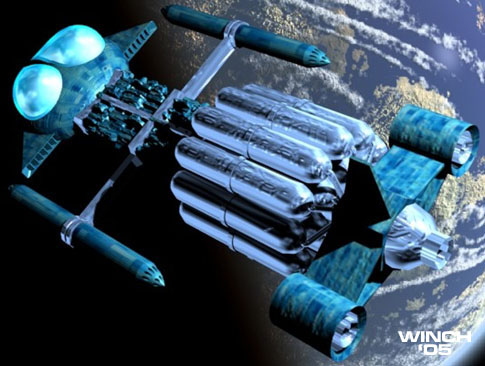
I was a fan of the old TV show Space: 1999. When I was designing the System ship, consciously in the back of my mind was the Mark IX Hawk attack spacecraft:
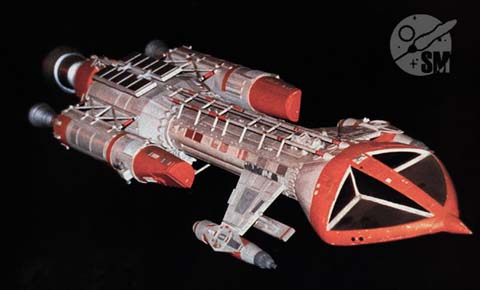
However, a gentleman named Raja Thiagarajan pointed out that unconsciously, at least, I must have had in the back of my mind the warships of Sidon from another Space 1999 episode. I was not aware of this, but upon looking at the images it is pretty clear to me that Mr. Thiagarajan is correct. My subconscious mind borrowed the bug-eyed nose section without informing me of the fact. Though mine are transparent glass and the Sidon ship's bug-eyes are metal.

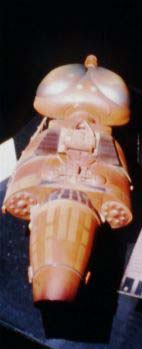
WarpWar analyst Henry Cobb estimates that the stats of the system ship in the drawing are approximately Power/Drive 4, Missile Tube 2, Missiles 6, Cost 8 BP.
Below you will find scans of my brainstorming artwork for Warp War, click on the thumbnails for a larger image.
For some perspective, here are the sort of spacecraft I was creating right before Warp War. Remember that I was a teen-ager at the time, so don't be too disappointed at how silly they are. Note the Sidon warship influence in the bottom right image.
(Note: if you do not see the thumbnails, it is probably because Norton Anti-Virus is set to block hot-links off-site)
In the Warp War illustration of the control room, I used my infamous "control pillar" design. This is a disc shaped table with a fat pillar down the center, with four or six workstations evenly spaced around. Computer monitors for each workstation are mounted in the pillar, though sometimes I have a shared spherical holographic display. I don't know when I came up with this idea, though it owes a lot to the control room in Mattel's Major Matt Mason's lunar station.
Click on thumbnails for a larger image.
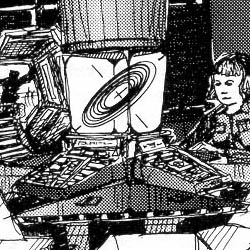 |
The control pillar from Warp War. |
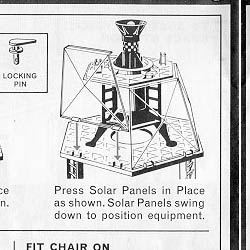 |
The instruction sheet for Major Matt Mason's lunar base. They don't make toys like this anymore. |
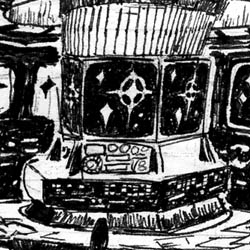 |
About 1971. This is probably the oldest image on this web page. The faint gray lines are the blue lines of the notebook paper. In the center column, near where it joins the table, are black panels of flickering lights. These owe much from the panels of parity light seen in the control room of Lost In Space and The Time Tunnel. |
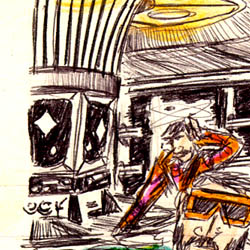 |
About 1972. O.M.A.C. stand for "Omni-Modal Analog Computer" while "Multscan" is a system tying a battery of sensors to computer analysis in order to infer details about the target that are not immediately apparent. Note the Classic Trek style chair. |
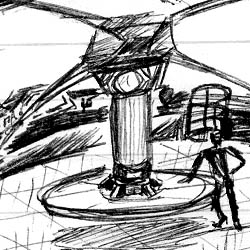 |
About 1973. A large control dome on the surface of a starship. This demonstrates an artistically showy but structurally insane method of incorporating a control column. Note the floating antigravity chair, the ladder way well in the upper right corner, and the boxlike telescope on swivel arms. |
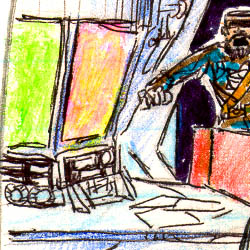 |
About 1973. This control column does continue through the table to the floor. The control column is in a sunken area much like the bridge of the Enterprise from Classic Trek. Skytrack is a computerized tracking system used for chasing bad guys and plotting interstellar battles. Note the transparent ceiling. The door has a trapezoid shape probably from Forbidden Planet. The sidearm in Cindy's holster is a variant of a Classic Trek phaser, and Cindy's physique betrays a mistaken knowledge of anatomy learned mostly from comic books. I believe that Cindy's gloves were from The Legion of Super Heros character, though I disremember which one. |
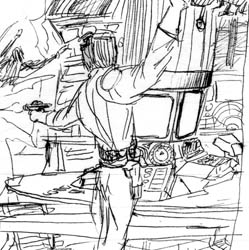 |
About 1973. Again the control column has no legs, is in a Star Trek like sunken area, and the sidearm is a modified phaser. |
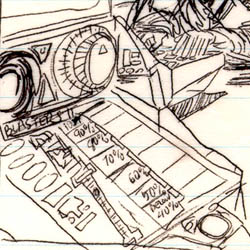 |
About 1973. A latter frame from the same source as the previous drawing. Note the separate buttons for each percentage strength setting, how silly. |
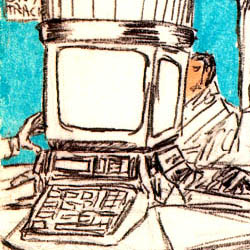 |
About 1975. Note the circular table has no legs, it is suspended from the ceiling. It has the same suspended chairs as the 1971 image. |
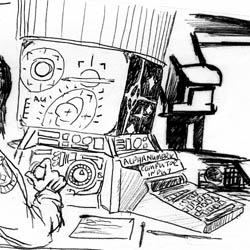 |
About 1975. The module at the right is labeled "Alphanumeric Computer Input." Wow, what a concept! The center monitor is displaying a star with an extended asteroid belt, with the scale in astronomical units. |
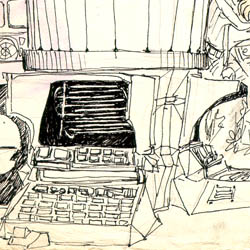 |
About 1975. More of the same. The fellow in the blue suit is a sort of self-portrait. |
 |
About 1976. Rather cramped, isn't it? The column in the center has a 3-D diagram of the galaxy used for navigation. |
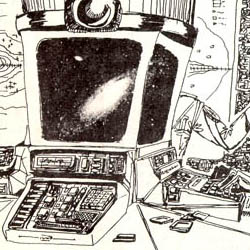 |
About 1977. A refinement of the first 1975 image. From a newsletter for the GALAXY-II pbm game. The contour chart on the rear wall is from a galactic map of the interstellar medium. The image in the pillar is a photo of the Andromeda Galaxy pasted onto the drawing. The character in the foreground is an action hero I formulated in grade school named "The Lone Wolf" (who is not native american despite the name. He is sort of an amalgamation of Buck Rogers (the 1930's comic version, not the TV show) and Captain Future from the novels of Edmond Hamilton. |
 |
A detail of the previous drawing. At the time I had not encountered a real computer but had read a lot of E.E. "Doc" Smith. Thus the controls are mostly analog, i.e., a discrete button for every function. I had just encountered the radical notion that a computer could control everything, and in turn be controlled by commands entered from a keyboard. Note the keyboard to the right, with the one-line alphanumeric readout and the fanfold printer ejecting paper. The square blocks are Classic Star Trek style record tapes, what we now would call Compact Flash memory cards. The instrument coated back wall owes a lot to the Nick Fury Agent Of Shield comic books by Jim Steranko. |
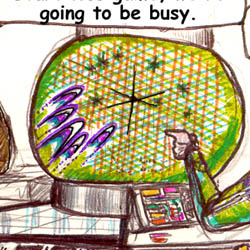 |
About 1980. Note the repulsor chair, using repulsion force fields instead of seat cushions. The "stress wakes in hyperspace" concept was cribbed from David Gerrold's YESTERDAY'S CHILDREN, and which later appeared in Glen Cook's PASSAGE AT ARMS. "Seetee" stands for "C.T." or "Contraterrene" aka Antimatter. The term is from the book of the same name by Jack Williamson and is used here as sort of a futuristic expletive. |
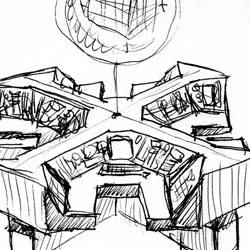 |
About 1999. An attempt to refine the control column concept. A cluster of four workstations with a spherical holographic display hovering in the center. |